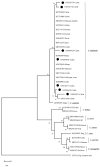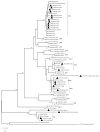Molecular Identification and Genotyping of Cryptosporidium spp. and Blastocystis sp. in Cattle in Representative Areas of Shanxi Province, North China
- PMID: 37760332
- PMCID: PMC10525831
- DOI: 10.3390/ani13182929
Molecular Identification and Genotyping of Cryptosporidium spp. and Blastocystis sp. in Cattle in Representative Areas of Shanxi Province, North China
Abstract
Both Cryptosporidium spp. and Blastocystis sp. are common intestinal protozoa, which can cause zoonotic diseases and economic losses to livestock industry. To evaluate the prevalence and genetic population structure of Cryptosporidium spp. and Blastocystis sp. in beef and dairy cattle in Shanxi Province, north China, a total of 795 fecal samples were collected from beef and dairy cattle in three representative counties in Shanxi Province, and these fecal samples were examined using molecular approaches based on 18S small-subunit ribosomal RNA (SSU rRNA) of Cryptosporidium spp. and Blastocystis sp., respectively. Among 795 cattle fecal samples, 23 were detected as Cryptosporidium-positive and 103 were detected as Blastocystis-positive, and the overall prevalence of Cryptosporidium spp. and Blastocystis sp. in cattle in Shanxi Province was 2.9% and 13.0%, respectively. For Cryptosporidium spp., DNA sequence analysis indicated that all 23 positive samples were identified as C. andersoni. Furthermore, five known subtypes (ST1, ST10, ST14, ST21 and ST26) and three unknown subtypes of Blastocystis sp. were detected among 103 positive samples using DNA sequence analysis. This study reported the occurrence and prevalence of Cryptosporidium spp. and Blastocystis sp. in cattle in Shanxi Province for the first time, which extends the geographical distribution of these two zoonotic parasites and provides baseline data for the prevention and control of these two important zoonotic parasites in cattle in Shanxi Province.
Keywords: Blastocystis sp.; Cryptosporidium spp.; Shanxi Province; cattle; genotypes; prevalence; subtypes.
Conflict of interest statement
The authors declare no conflict of interest.
Figures



Similar articles
-
First Molecular Identification of Entamoeba spp. in Sheep, Beef Cattle, and Dairy Cattle in Shanxi Province, North China.Vet Sci. 2025 Jan 4;12(1):19. doi: 10.3390/vetsci12010019. Vet Sci. 2025. PMID: 39852894 Free PMC article.
-
Occurrence and genotypic identification of Blastocystis sp., Enterocytozoon bieneusi, and Giardia duodenalis in dairy cattle in Heilongjiang Province, China.Parasitol Int. 2024 Jun;100:102871. doi: 10.1016/j.parint.2024.102871. Epub 2024 Feb 24. Parasitol Int. 2024. PMID: 38403046
-
Prevalence and Genetic Characterization of Giardia duodenalis and Blastocystis spp. in Black Goats in Shanxi Province, North China: From a Public Health Perspective.Animals (Basel). 2024 Jun 17;14(12):1808. doi: 10.3390/ani14121808. Animals (Basel). 2024. PMID: 38929427 Free PMC article.
-
Foodborne concerns of Blastocystis spp. in marine animals (fish, bivalves, and sponges): A systematic review and meta-analysis of global prevalence and subtypes distribution.Food Waterborne Parasitol. 2024 Aug 25;36:e00242. doi: 10.1016/j.fawpar.2024.e00242. eCollection 2024 Sep. Food Waterborne Parasitol. 2024. PMID: 39282659 Free PMC article. Review.
-
Global Epidemiology and Subtype Distribution of Blastocystis sp. in Birds: A Systematic Review and Meta-Analysis.Foodborne Pathog Dis. 2025 Mar 10. doi: 10.1089/fpd.2025.0007. Online ahead of print. Foodborne Pathog Dis. 2025. PMID: 40059724 Review.
Cited by
-
Molecular Identification and Survey of Cyclospora spp. in Cattle in Shanxi Province, North China.Animals (Basel). 2024 Jul 20;14(14):2114. doi: 10.3390/ani14142114. Animals (Basel). 2024. PMID: 39061576 Free PMC article.
-
Prevalence and genotype/subtype distribution of Enterocytozoon bieneusi and Blastocystis in donkeys in Shanxi Province, north China.Parasitol Res. 2024 Jan 24;123(1):108. doi: 10.1007/s00436-024-08128-x. Parasitol Res. 2024. PMID: 38263530
-
Molecular Epidemiological Survey of Cryptosporidium in Ochotona curzoniae and Bos grunniens of Zoige County, Sichuan Province.Animals (Basel). 2025 Jul 19;15(14):2140. doi: 10.3390/ani15142140. Animals (Basel). 2025. PMID: 40723603 Free PMC article.
-
First Molecular Identification of Entamoeba spp. in Sheep, Beef Cattle, and Dairy Cattle in Shanxi Province, North China.Vet Sci. 2025 Jan 4;12(1):19. doi: 10.3390/vetsci12010019. Vet Sci. 2025. PMID: 39852894 Free PMC article.
-
Molecular prevalence and subtype distribution of Blastocystis spp. among children who have diarrheia or are asymptomatic in Wenzhou, Zhejiang Province, China.Parasite. 2024;31:12. doi: 10.1051/parasite/2024012. Epub 2024 Mar 6. Parasite. 2024. PMID: 38450718 Free PMC article.
References
-
- Thompson R.C., Olson M.E., Zhu G., Enomoto S., Abrahamsen M.S., Hijjawi N.S. Cryptosporidium and cryptosporidiosis. Adv. Parasitol. 2005;59:77–158. - PubMed
Grants and funding
- SXBYKY2021019/Shanxi Province Excellent Doctoral Work Award-Scientific Research Project
- 20211331-13/the Fund for Shanxi "1331 Project"
- SXIHLT001/the Research Fund for Introduced High-level Leading Talents of Shanxi Province
- 2021XG001/the Special Research Fund of Shanxi Agricultural University for High-level Talents
LinkOut - more resources
Full Text Sources
Miscellaneous

